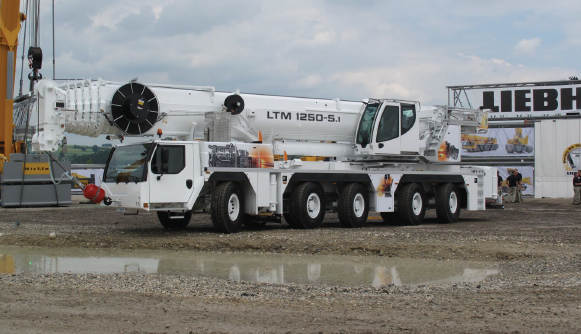
The LTM 1250-5.1 has a 15% to 20% increased load capacity over the LTM 1220-5.2 but uses the same 197-ft. telescopic boom. With lattice extensions, the maximum hook height has been increased to 360 ft.
A range of lattice jibs are available on the LTM 1250-5.1. The 40- to 72-ft. folding jib can be extended up to 118 ft. with 23-ft. sections. The folding jib is attached with a 0°, 22.5°, or 45° inclination. As an option, the folding jib can be supplied with a hydraulic adjustment system, which allows it to luff with a full load between 0° and 45°. The adapter section for the folding jib is used as a 18-ft. erection jib. The pivot point for the folding jib can be raised using up to two straight 23-ft. lattice sections acting as telescopic boom extensions. These sections and folding jib extensions can also be used on the Liebherr LTM 1200-5.1 and LTM 1220-5.2 mobile cranes.
To mount a long fixed jib up to 164 ft. on the five-axle crane, Liebherr has created a solution using just one additional TF adapter (connection between the telescopic boom and the fixed jib), a reducer section, and a head. The existing telescopic boom extensions and folding jib extensions are used. The jib is hydraulically adjustable between 0° and 45° and can therefore be used like a luffing jib.
Maximum ballast on the LTM 1250-5.1 is 97 tons with a maximum width of 21 ft. The base plate, which weighs 1.1 ton, and an 11-ton ballast plate are the same width as the vehicle. With up to 75 tonnes of ballast, the ballast width is 13 ft.
The LTM 1250-5.1 can be operated with two different ballast radii: 18 or 16 ft. Liebherr has designed a solution to adjust the ballast radius with the VarioBallast feature. The ballast radius is reduced by 800 mm using standard mechanically swivelling ballasting cylinders.
Single-engine design
The Liebherr single-engine concept is once again used on the LTM 1250-5.1, with the superstructure being powered by a mechanical shaft. Gear shafts are routed from the distributor gear in the substructure via two mitre gears through the centre of the slewing ring to the pump distributor gear in the superstructure.
According to Liebherr, a mechanical shaft ensures high efficiency and low engine speeds in the chassis engine. It reports that the benefits of not having a separate superstructure engine include reduced maintenance work and lower weight. The lower weight can be used for load-bearing components, thus increasing the crane's load capacity.
Power is transferred to the crane's axles by the 12-speed ZF-AS-Tronic gearbox. A two-stage distributor gear permits minimal creeper speeds in the manoeuvring mode. The intarder, a zero-wear hydrodynamic brake integrated in the gearbox, acts as a retarder. A Telma eddy current brake is also available as an option.
The LTM 1250-5.1 is fitted with pneumatic disc brakes. The rear axles have active electro-hydraulic steering depending on the vehicles speed. This increases manoeuvrability and reduces tire wear. Five steering options are available.
ECOmode feature
In conjunction with the single-engine concept, Liebherr has developed ECOmode, an add-on program for the new crane drive concept. The complete pump drive can be automatically disconnected when the engine is idling and reconnected through the intelligent controller in a matter of seconds when it is required.
Liebherr has also developed a special mode for mobile cranes in the load-sensing range to reduce the cost of crane use while also reducing noise emissions. ECOmode minimizes fuel consumption and noise emissions when operating the crane superstructure. With ECOmode, the crane operator sets the required working speed using the control lever. The LICCON2 controller then calculates the perfect engine speed for it. The value is set on the crane engine using the engine control unit.
Compared to using a constant and therefore mostly excessive engine speed, the result of the adjustment of the engine speed reduces fuel consumption and minimizes noise emissions.
Source: Crane & Rigging Hotline Magazine